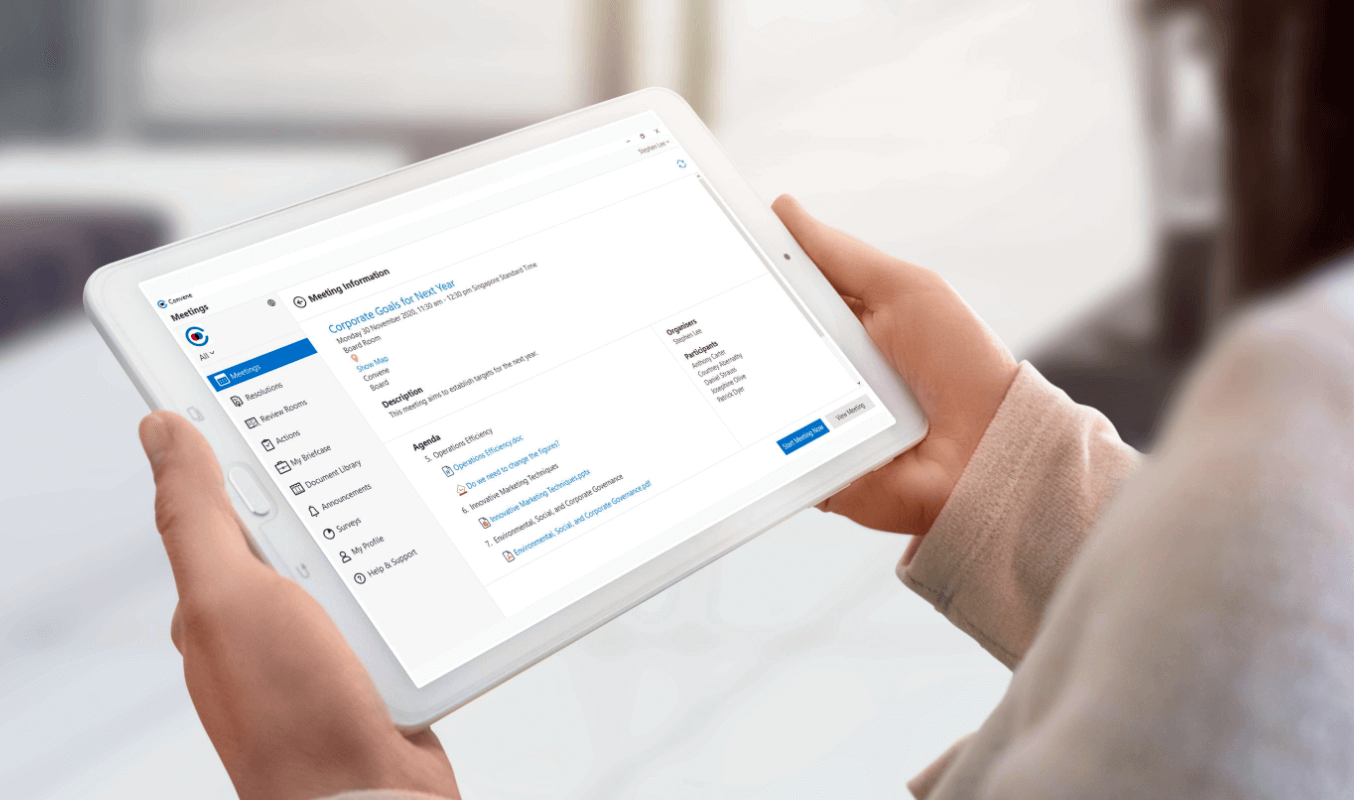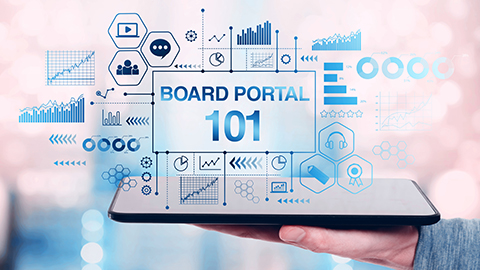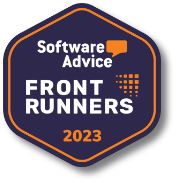How long does it take for meeting organizers to compile board packs? With manual execution, it could take them three to seven days for preparation, one to three days for distribution, and seven to ten days for review. It would take almost a month for corporate secretaries and board administrators to prepare for a single board meeting. As technological solutions are now widely available, how can boards automate board pack compilation?
What is a board pack?
All corporations and their boards have unique goals and needs. Corporate secretaries must be able to attain and reach those goals by keeping the boards updated with insightful and credible information about the company. With that being said, those information — reports, analyses, and trends — are what you put together in a board pack to inform the boards of their discussions before the meetings.
Board packs, also called meeting packs, are well-documented and sourced documents that are essential to board meetings. These are vital as they keep board members up-to-date with the corporation’s results, threats, opportunities, and plans. Moreover, it provides the information the board needs to aid in their decision-making. Board packs also keep board members productive and focused on the topic at hand throughout board meetings.
What is included in a board pack?
The board pack contains information from a previous board meeting and the matters to be discussed in the present meeting. While board matters may be overwhelming, as the corporate secretary, you should only include information that has significance to the upcoming meeting. The board may specify what information is needed in an upcoming board meeting, but this is not usually the case.
A board pack may consist of the following, but not limited to these standard documents:
- Pending action items
- Unresolved issues that need further discussion
- Developments and Performances
- Reports (e.g. progress report, board committee report, and financial report)
- Documents that need approval
- Items in need of board correspondence
- Board resolutions
- Minutes of the previous meeting
- Agenda of the upcoming meeting
This only serves as a guide on the board pack’s scope of coverage. It is up to your best judgment on what to include and report in the board pack. The goal is to prepare a board pack that is credible and concise, without any gray areas, and able to cover critical issues that need the board’s attention.
The Challenges in Compiling Board Packs
The accuracy of the information in the board pack is a big responsibility for corporate secretaries as the board trusts every information found in the board pack. Thus, the challenge for corporate secretaries is to ensure the relevance and cohesiveness of the board pack without sacrificing conciseness. Here are some of the hurdles you might face when preparing a board pack.
Running Hundreds of Pages Manually
In paper-based meetings, the board pack process starts with compiling the documents that need to be included in the board pack. Usually, the documents can span hundreds of pages long. Once the board pack is prepared, the next step is to print and compile the documents en masse, making sure that there aren’t any missing pages or documents. The board packs are then ready for send-out and are disseminated to each board member.
However, the board pack process isn’t always smooth sailing. Although the board pack undergoes approval before printing and send-out, there are times that it needs a few changes. Any changes to the board pack would call for readjusting and reprinting the board pack. This means that more time, effort, paper, and other resources are spent every time there are adjustments in the board pack. This is inefficient as you could have reallocated your time and resources towards more critical tasks given your busy schedule.
Putting Too Much Information
The board pack often consists of critical data for the board, that is why there are times when it is flooded with hundreds of pages worth of information. Having more information doesn’t always mean it’s better. Board members often get overwhelmed with the information — the board pack should be able to prepare board members for the upcoming meeting, not further complicate them.
This becomes a dilemma for corporate secretaries as board packs should be prepared in such a way that it is comprehensive and easily digestible. You can’t take out information just for the sake of shortening the board pack. Keep in mind that the quality of the board pack is still greater than the quantity of information you present.
Insufficient Time to Review the Board Pack
Due to the board’s nature of work, board members have a hectic schedule. Hence, they may not have enough time to go through the whole board pack. One of the best practices in preparing board packs is to prune unnecessary details. Take note of the big picture as this is what the board prefers most of the time. It is also a good practice to have a lead time when sending out board packs.
Automating Board Pack Compilation
Considering the pain points of company secretaries when preparing a board pack, one way to ease the burden is to digitalize the board pack preparation process.
Work with Templates and Schedules
The board decides on the format of the board pack, as they are particular about the way they want the information presented to them. Thus, it is important to have templates for the sake of practicality and convenience. Having a template provides structure and consistency for the board pack. It keeps you on track of what information should only be included and helps you control the length of the board pack by straying away from presenting irrelevant matters to the board members.
A good practice is to set templates for the reports with a good balance of graphs and texts. A wordy report might discourage the board from reviewing the board pack, whereas the board may not fully comprehend a report full of graphs. Keep in mind also that reports and other content should flow naturally so the board can easily navigate the board pack. Moreover, templates cut the excessive consumption time and resources in preparing board packs.
Time is of the essence when preparing board packs. Having a lead time is important as it allows board members to review and understand the whole board pack. Thus, setting deadlines in advance helps you to avoid procrastinating the preparation of board packs. This also gives you ample time to revise the board pack should there be a need for it.
Be sure to plan ahead of time and stick with your deadline to avoid late distribution of the board pack. Make sure that the timeframe that you will allot for preparing board packs is realistic and reasonable. When planning your board pack preparation workflow and setting deadlines, take into consideration other tasks you need to accomplish to avoid delays. As a best practice, the board must receive their board packs at least a week before the board meeting.
Employ a Board Portal to Digitalize the Process
In today’s modern era, companies are more open to digital transformation. Missing out on transitioning to digital solutions has some disadvantages. Automating the board pack preparation can mean elevating the workflow by going digital.
A board portal, such as Convene, digitalizes the process and further simplifies your board pack preparation workflow. It has intuitive features that save you the trouble of the tedious board pack process, allocating resources to more value-adding tasks instead. Below are some board portal features that will help you optimize your board pack preparation process:

1. Build agenda instantly in a single space
Utilizing various apps and software to format and convert file types can break your momentum. A board pack comes in handy as it allows you to work in a single space thus lessening the distractions on your computer. It enables you to concentrate more on the content of the agenda rather than on the format. Furthermore, the convenience of doing everything on just one platform enhances your efficiency and productivity.
2. Attach important documents easily
With ease of use in mind, board portals allow you to drag and drop files onto the board pack. This speeds up the process as you can easily drag files from your device and drop them onto the particular agenda items you are working on. No need to attach documents manually. With this feature, you can effortlessly add, remove, and rearrange important documents and agenda items.
3. Organize the presentation of reports
Using a board portal allows you to boost the board’s coordination. This means you can assign the presenters per agenda item during the meeting. Setting the duration time of the meeting helps the board to be productive and compliant with the meeting schedule. Additionally, the board portal allows assigning vote items on specific meeting matters.
4. Circulate board packs and notify board directors of the meeting in just one click
Distributing physical copies of board packs can be a lot of work, especially when some of the board members don’t usually work in the office. A board portal aids in distributing board packs, plus it is a more secure mode of dissemination than emails.
With a board portal, you can distribute and monitor the delivery of board packs. Any last-minute revisions can be easily circulated with just a few clicks. It also allows you to keep a copy of the older versions of files whenever you upload new versions.
5. Manage documents in a secure repository
With a board portal, all documents and board packs are systemically stored in a repository. Having cutting-edge security features in repositories ensures that documents are only accessible to only the intended recipients — preventing unwanted access and data breaches. Furthermore, a board portal also allows integration with third-party repositories for a streamlined retrieval of documents.
6. Allow directors to review and annotate documents
Board members can easily review their meeting packs anytime and anywhere whether they are online or not, even before the board meeting. The board portal’s powerful tools, such as private and shared annotations further elevate the collaboration of the board to address matters at hand.
7. Do everything paperless
Thousands of papers consumed for board meetings take a toll on the environment. The digital revolution is becoming the norm as more and more companies strive to be more sustainable. One of the first few steps of the digital revolution is using paperless meeting solutions. A board portal enables you to organize more secure, efficient, productive, and sustainable meetings. Gone are the days when you have to manually create meeting packs, physically distribute, and have them reviewed. With board portals, board pack preparation and review are now as simple with just a few taps or clicks. Board portals replace the bulky board packs with the board members’ own devices.
Optimizing the Process of Board Pack Preparation
Board packs give the board insights about the company’s history, current state, and anticipated future. The board has to make informed decisions using data and insights on the board pack. It is the duty of corporate secretaries to make sure that the board is well-educated by providing an accurate, informative, and reliable board pack. Corporate secretaries have sought ways of optimizing the processes in preparing board packs. Using a board portal can help expedite the preparation and support decision-making.
Convene is a board portal designed to cater to the needs of corporate secretaries and board members in streamlining the entire meeting process. Its simple, and intuitive features elevate the standards of meetings as well as corporate governance. Say goodbye to bulky board packs, decrease your expenses when preparing for meetings, and reduce logistical needs with Convene. Sign up and get a free trial of our board portal today.
Jielynne is a Content Marketing Writer at Convene. With over six years of professional writing experience, she has worked with several SEO and digital marketing agencies, both local and international. She strives in crafting clear marketing copies and creative content for various platforms of Convene, such as the website and social media. Jielynne displays a decided lack of knowledge about football and calculus, but proudly aces in literary arts and corporate governance.












